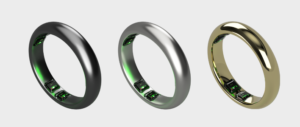
Wearable technology has come a long way since its inception in the early 1960s. The first modern wearable technology was created in 1961 by Claude Shannon and Edward Thorpe, which was a small four-button computer that could easily fit into a person’s shoe or be strapped around their waist.
The next frontier for Wearable Technology is Smart Rings. Smart rings are a relatively new category of wearable technology that have been gaining popularity in recent years. They are small and discreet wearables that can be worn on the finger, and they offer a range of features such as fitness tracking, health monitoring, and contactless payments Smart rings are small and discreet wearables, ideal for people who want to get the benefits of a wearable, without wearing bulky smartwatches or fitness trackers.
However, if you compare the two markets today, there is still a lot of catchup for the Smart Ring Market size. According to Verified Market Research, the Smart Ring Market size was valued at USD 4.10 Million in 2021 and is projected to reach USD 22.49 Million by 2030, growing at a CAGR of 20.8% from 2023 to 2030.
In comparison, the global smartwatch market size reached US$ 37.6 Billion in 2022., with a growth rate (CAGR) of 19.9% during a five year period. This would project the market to reach US$ 113.9 Billion by 2028.
Iris Takes Smart Rings to the Next Level
Looking to transform the technology is the Iris Smart Ring. It has a lightweight fit, quick charges, and an impressive health suite that focuses on a variety of factors. The Iris smart ring captures data related to heart health, blood oxygenation, calories burned, steps taken, respiration rate, body temperature, blood pressure, stress sleep and even fertility.

The Iris Ring features advanced PPG sensors that meet healthcare technology standards. A Photoplethysmography (PPG) module is made up of a LED that shines light into the skin and a photodetector that collects that light from the tissue.
Iris monitors your heart rate and its variability 24/7 and displays, via the app, the following data: – Min HR, in bpm – MAX HR, in bpm (beats per minute). You’ll be able to track your sleep stages in real-time : Awake, REM, Light Sleep, Deep Sleep.

The blood pressure algorithm looks for specific patterns and features in the captured PPG data to assess the blood pressure readings: systolic blood pressure (SBP), diastolic (DBP) and mean (MBP)
Iris Ring is embedded with tiny LED lights that can be customized to shine in different colors (blue, green or red).
The charger can charge your Iris Ring in as little as 20 to 40 minutes, depending on the state of charge. Once fully charged, the Iris Ring can last for up to three days, giving you the freedom to go about your day without having to worry about running out of battery.
While smart rings are becoming increasingly popular, they are still a relatively new technology. As such, there are still many questions how they will impact the wearable market. Ultimately, the choice between a smart ring or smartwatch comes down to personal preference and lifestyle. However, it is clear that smart rings have come a long way since their inception and will continue to evolve in the future.
Features and Specifications
- Styles: Obsydian, Titanium, Aureate
- Size range: US 6 – 14
- Material: external surface is made of durable PVD coated metal (Gold, Silver). The Black color is made in high quality scratch resistance non allergic glossy black resin.
- Sensors: 6 photodetectors and 18 LEDs
- Waterproof: You can use the ring while swimming or bathing (up to 100 meters or 330 feet).
- Flight mode option: allows users to turn off the electromagnetic field (EMF) emissions when necessary.
- Estimated Shipping: January 2024
For more information about Iris Smart Ring
